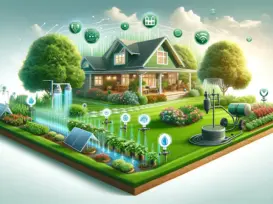Grus Home Energy - rainwater harvesting
Maximizing Water Conservation: Innovative Strategies for Rainwater Harvesting
Maximizing Water Conservation: Innovative Strategies for Rainwater Harvesting
In an era where water scarcity is becoming an increasingly pressing concern, rainwater harvesting stands out as a beacon of sustainability and conservation. It is a simple yet effective technique that involves collecting, storing, and utilizing rainwater for various needs. Rainwater harvesting can significantly reduce our dependence on municipal water supplies, lower utility bills, and lessen the environmental impact of overusing natural water sources.
The principle behind rainwater harvesting is straightforward: capture the water that falls on your roof and other surfaces during precipitation events before it becomes runoff. This water is then directed to a storage system, typically a tank or barrel, where it can be held for future use. The process not only helps in saving water but also in reducing soil erosion and flooding in urban areas.
One of the most innovative strategies for rainwater harvesting is the incorporation of green roofs. Green roofs are covered with vegetation and soil, which not only insulate buildings and improve air quality but also absorb and store rainwater. This water can then be used for non-potable purposes such as irrigation, flushing toilets, and even cooling building systems.
Another advanced technique is the creation of rain gardens. These are shallow, vegetated basins that collect rainwater runoff from impervious surfaces like roofs, driveways, and streets. Rain gardens slow the runoff and allow it to infiltrate into the ground, thereby recharging groundwater sources and filtering pollutants.
In urban areas, where space is often at a premium, innovative multi-tiered rainwater harvesting systems can be installed. These systems use a combination of underground and above-ground storage tanks that are interconnected. Such configurations maximize storage capacity and can be tailored to fit specific site conditions and requirements.
Smart technology also plays a significant role in modern rainwater harvesting systems. Automated controls can be used to switch the source of water supply from rainwater to the municipal system when the tanks are low, ensuring a constant supply. Additionally, real-time monitoring of rainwater levels can be done through mobile applications, allowing users to manage their water resources more efficiently.
Rainwater harvesting is not only about installing systems but also about community engagement and education. Public awareness campaigns and workshops can teach individuals how to build and maintain their rainwater harvesting systems. Moreover, incentives and rebates from governments can significantly boost the adoption of such practices.
However, it’s essential to treat and maintain the harvested water correctly to ensure it’s safe for use. Depending on its intended use, rainwater may require filtration and disinfection to remove debris, bacteria, and other pollutants. Regular maintenance of the catchment area, gutters, and storage tanks is crucial in preventing contamination.
In summary, rainwater harvesting is an ancient practice that modern technology has revitalized, providing an effective solution to water scarcity and conservation. By implementing innovative strategies such as green roofs, rain gardens, and smart monitoring systems, individuals and communities can play a significant role in sustainable water management. As the global population grows and climates change, the importance of rainwater harvesting cannot be overstated—it is a vital component of a sustainable future for all.
©2025 All Rights Reserved. Grus IoT Co.,Ltd.
